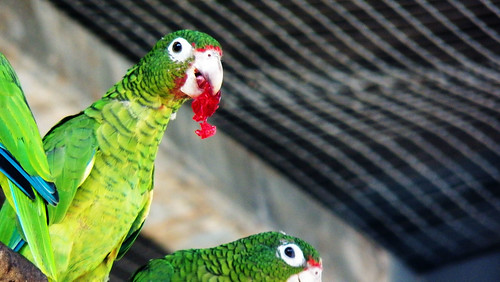 Puerto Rican Parrot eating a fruit. Image by Danna Liurova, USFWS YAPRIO ABAJO NATURE PRESERVE, Puerto Rico (AP) One of the world's most endangered bird species has made a major comeback in the U.S. territory of Puerto Rico.
Puerto Rican Parrot eating a fruit. Image by Danna Liurova, USFWS YAPRIO ABAJO NATURE PRESERVE, Puerto Rico (AP) One of the world's most endangered bird species has made a major comeback in the U.S. territory of Puerto Rico.
The counted population of the Puerto Rican parrot fell to just 13 during its darkest days, but researchers said Thursday that nearly 400 parrots are now in captivity and more than 100 being tracked in the wild across the island.
Scientists working in the Rio Abajo Nature Preserve in western Puerto Rico also found a wild nest with eggs, the first discovery of its kind in 42 years.
"This is a huge step," said Gustavo Olivieri, coordinator of the Rio Abajo parrot reintroduction program. "It shows the population can sustain itself."
The eggs did not hatch, but scientists said that is not unusual and they are encouraged that formerly captive parrots were procreating in the wild and building nests.
The birds are the island's only remaining native parrot and one of roughly 30 species of Amazon parrots found in the Americas. They have red foreheads, turquoise feathers under their wings and grow to nearly a foot in length. They are known for their secrecy and usually mate for life, reproducing once a year.
This year, a record 51 baby parrots were born in captivity in the Rio Abajo forest, up from a previous record of 34 born in 2011, said Ricardo Valentin, a biologist with the island's Department of Environment and Natural Resources. The number of parrots born in the wild also increased slightly to a record 15, up from 12 last year, he said.
While the researchers' goal is to release parrots into the wild with temporary radio collars, some are too aggressive or weak and are instead kept captive, Olivieri said.
Scientists estimate that as many as 1 million Puerto Rican parrots lived in pre-colonial times, but their habitat was destroyed by the clearing of forests in the late 1800s to plant citrus, coffee and sugar cane.
By the 1950s, there were only an estimated 200 parrots in the wild, and numbers reached a low of 13 in 1975.
"Very few species in the world have been so close to extinction like the Puerto Rican parrot," said Leopoldo Miranda, assistant regional director for the U.S. Fish and Wildlife Service.
The population later grew to nearly 50 by 1989, but Hurricane Hugo killed nearly half of them, prompting officials to create a second reserve to make them less vulnerable. Now they are hoping to open a third in western Puerto Rico.
Scientists launched the captive breeding program in 1972, with the first chick being born in 1979, and the rate of success grew as biologists and technicians learned more about the birds.
While Puerto Rican parrots are still considered an endangered species, Miranda said the population increase "is an incredible achievement."